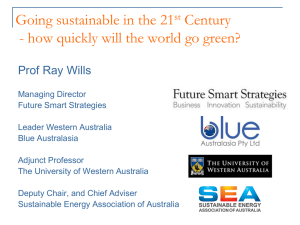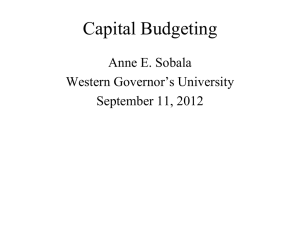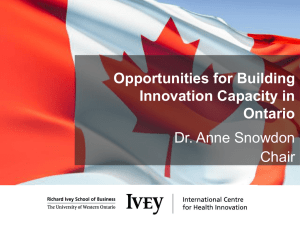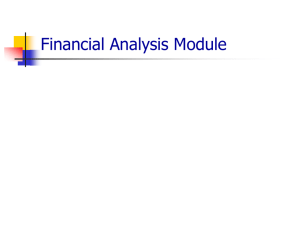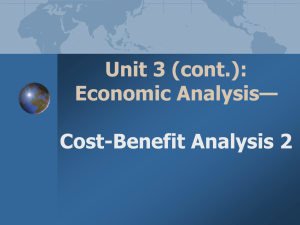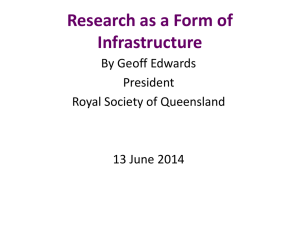assessment of prospective impact of fruits and
advertisement
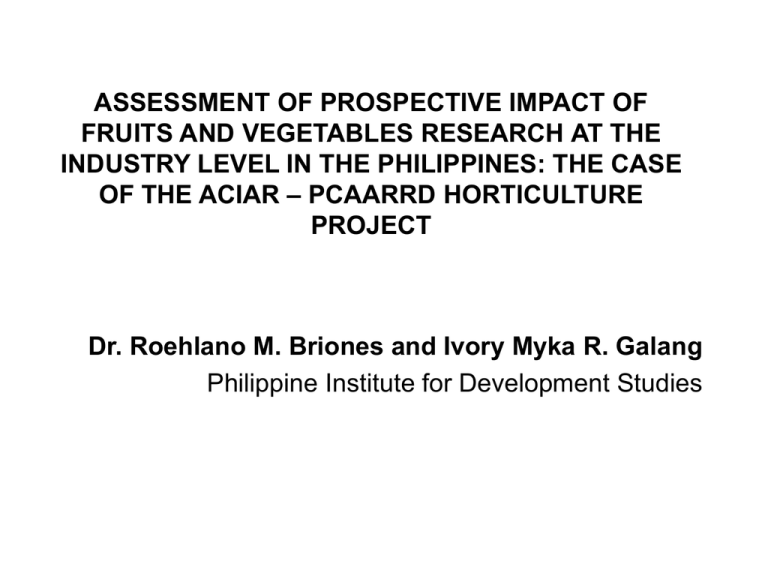
ASSESSMENT OF PROSPECTIVE IMPACT OF FRUITS AND VEGETABLES RESEARCH AT THE INDUSTRY LEVEL IN THE PHILIPPINES: THE CASE OF THE ACIAR – PCAARRD HORTICULTURE PROJECT Dr. Roehlano M. Briones and Ivory Myka R. Galang Philippine Institute for Development Studies Outline • • • • • Objectives Research and Development (R&D) Assessment method Results of the assessment Analysis of the results Objectives • Analyze the contribution of the fruits and vegetables subsector in agricultural development. • Evaluate the potential impact of R&D on selected horticulture crops. • Draw implications for investment allocation and institutional framework for the agricultural R&D system. Research and Development • Budgetary allocation trend – Table 1. By Major Final Output (OPIF; World Bank ; in P millions) 2001 MFO 1 Support services MFO 2 Regulations 20,199 2002 2003 2007 2008 2009 2010 21,758 18,702 14,748 20,803 36,006 33,858 512 2,257 2,244 689 1,186 1,197 1,353 MFO 3 Plans and policies 2,076 1,382 1,103 3,059 1,767 2,469 2,617 TOTAL 22,787 25,397 22,049 18,496 23,756 39,672 37,828 Research and Development • Budgetary allocation trend – Table 2. Breakdown of MFO 1 (OPIF; World Bank; in P millions) 2001 2002 2003 2011 Production Support Services 2,523 2,468 4,608 4,975 Market Development Services 267 143 115 242 Credit Facilitation Services 312 124 184 23 Irrigation Development Services 9,981 13,124 9,044 12,552 Other Infra and/or Post harvest Dev't Services 2,800 2,012 1,667 716 Extension Support, Education and Training Services 2,630 2,514 2,126 1,853 Research and Development 1,686 1,373 958 1,185 Research and Development • Investment in agricultural R&D – one of the major drivers of agricultural productivity. • Most of the agricultural research and development efforts (funding) come from the government agencies. – Agricultural research as a public good – Stakeholders (workers and farmers) are poor Research and Development • General trends – Table 3. Global public agricultural research-intensity ratios, 1981-2000 Expenditures as a % of AgGDP Region/country Developing countries Sub-Saharan Africa China Asia and Pacific Latin America and Caribbean Middle East and North Africa Developed countries Total 1981 0.52 0.84 0.41 0.36 0.88 0.61 1.41 0.79 1991 0.50 0.79 0.35 0.38 0.96 0.54 2.38 0.86 2000 0.53 0.72 0.40 0.41 1.16 0.66 2.36 0.8 Research and development • Public-sector agri research intensity ratio, 2002 • PHILIPPINES: 0.46 % – Higher than Vietnam [0.17 %], Indonesia [0.22 %], Laos [24%] – Lower than Malaysia [1.92 %] – Higher than the overall average for Asia (2000) : 0.41 % – Lower than the average for developing countries (2000) : 0.53 % Research and Development Rice Corn Sugar Coconut Fiber Crops Cotton Abaca Other fiber crops Vegetables Tobacco Livestock Carabao Other livestock Fruits Banana Other fruits Fisheries excl. SEAFDEC incl. SEAFDEC Forestry Source: David (1998) Research Intensity Ratio 1994-1996 0.25 0.05 0.5 0.3 2.5-3.0 2.5 1 nil 1.1 0.15 3.6 0.02 nil nil 0.12 0.35 3.5 Banana Livestock Poultry 2012 GVA Shares 6.93 12.79 7.47 Assessment Method • Economic Surplus Approach – Change in economic surplus arises from farm productivity improvement due to innovation (kshift), which propagates by a diffusion process – Together with research cost, permits calculation of measures of project worth • Net present value (NPV) • Benefit-cost ratio (BCR) • Internal rate of return (IRR) http://www.web-books.com/eLibrary/NC/B0/B63/032MB63.html Assessment method • K-shift NPV, BCR, & IRR • Unable to get good estimates of k-shift Reverse • NPV, BCR, and IRR threshold k-shift – minimum value to justify the amount invested in the research – NPV=0, BCR=1, IRR= discount rate A model named ‘welfare impact simulator for evaluating research’or WISER has been developed to automatically calculate the prospective impact of a new technology generated from fruit and vegetable R&D. Philippines Horticulture Program • Fruits – C1: Analysis of Papaya supply chain constraints – C2: Durian/Jackfruit Phytophthora Integrated Management – C3: Papaya Integrated Crop Management – C4: Improved and Sustainable Mango Value Chain • Vegetables – C1: Integrated soil and crop nutrient management – C2: Development of a cost-effective protected cropping system – C3: Management of bacterial wilt and other wilting diseases in Solanaceous crops – C4: Analysis of selected vegetable value chains • Fruits and vegetables – C5: Economic impacts of new technologies and policy constraints • Research cost: financing by the Australian Centre for International Agricultural Research (ACIAR) and in-kind contribution by the Philippines. Assessment method Assumptions to calibrate the diffusion process: • High adoption scenario – admax (maximum adoption): 20 % – adop20 (adoption after 20 years) : 15 % • Low adoption scenario – admax : 5 % – adop20 : 4 % Assessment method • Table 4. Research cost (over 4 years) Durian Jackfruit Mango Total investment in Philippines inthe Philippines, in kind, in AUSD$ AUD$ 18,200 201,345 TOTAL 219,545 " " " 430,091 56,504 486,595 Preliminary results • Table 5. Threshold k-shift estimates in percent IRR 0.05 Durian Jackfruit Mango IRR 0.15 LOW adoption HIGH adoption LOW adoption HIGH adoption 2.4 8.5 0.8 0.8 2.8 0.3 11.4 30.7 4.2 4.9 15.6 1.7 NPV=0; BCR=1 (Evenson, 2003) Pearl millet Sorghum Groundnut k-shift (%) 18 to 59 12 to 26 15 Analysis of the Results • Modest levels of k-shift are needed to justify research investment • It is expected that the actual k-shifts of the research project would be higher than the kshift estimates in this study. • The computed k-shifts can help the research stakeholders to potential benefit of research to society via farm-level productivity improvement



